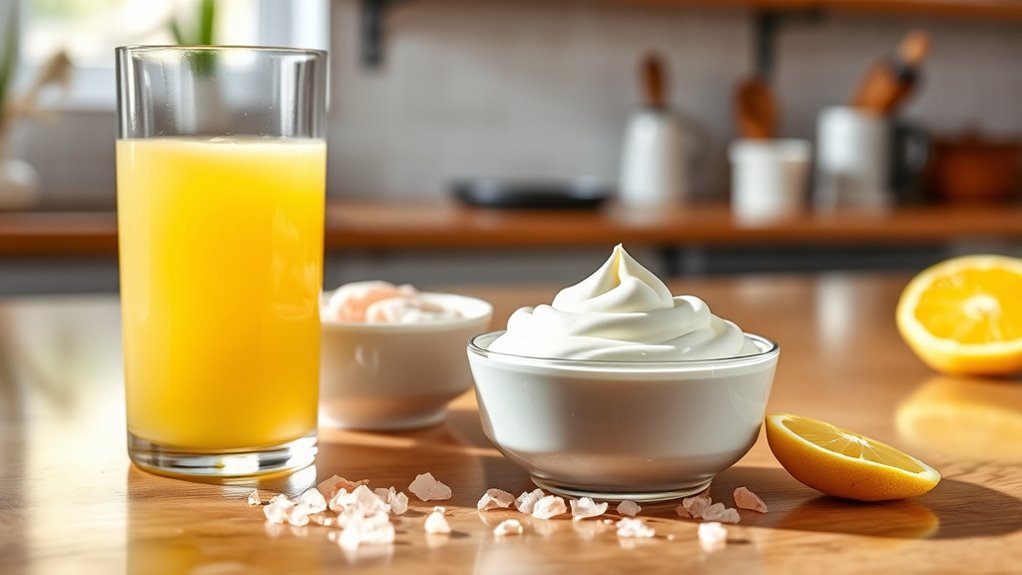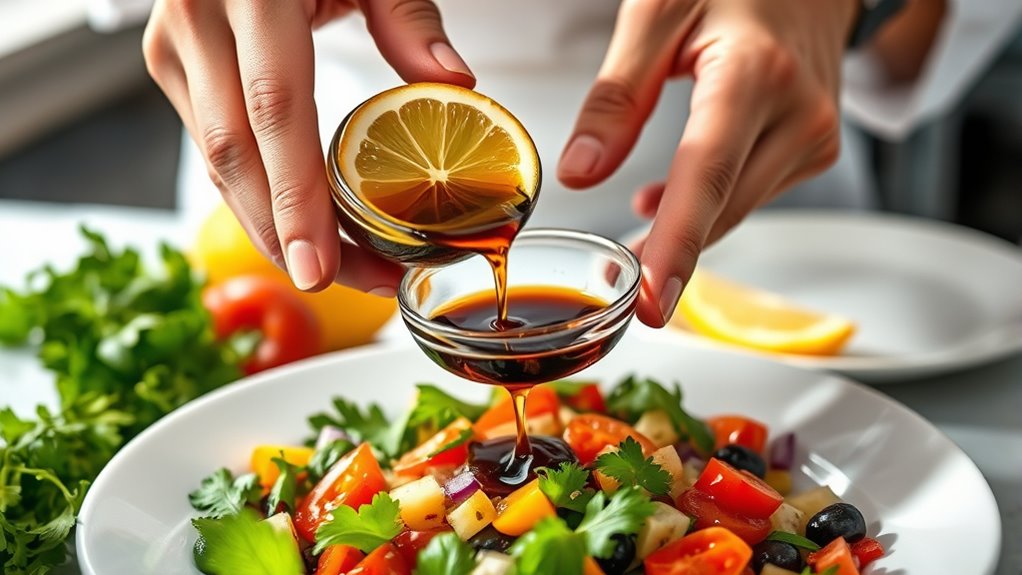Understanding acidity and balance in cooking helps you elevate flavors and create harmony in dishes. Acidity brightens ingredients, cuts through richness, and tenderizes meat, while also balancing sweetness and bitterness. By experimenting with different acidic components, you learn how they transform textures and flavors, shaping a well-rounded meal. Mastering these concepts allows you to develop your palate and craft more vibrant, memorable dishes. Keep exploring these principles, and you’ll discover even more culinary potential.
Key Takeaways
- Acidity acts as a natural flavor enhancer, brightening dishes and adding vibrancy.
- Balancing acidity with fats, sugars, and proteins creates harmony and depth in flavors.
- Proper acidity can tenderize ingredients and improve texture during cooking.
- Adjusting acidity influences ingredient interactions, shaping overall flavor profiles.
- Experimenting with different acidic components helps develop a refined palate and enhances dish complexity.

Understanding acidity and balance is essential to creating dishes that are lively and well-rounded. When you grasp how acidity influences flavor, you can transform simple ingredients into complex, memorable meals. Acidity acts as a natural flavor enhancer, brightening dishes and making other ingredients pop. For example, a splash of lemon juice or vinegar can elevate the taste of roasted vegetables, seafood, or even hearty stews. It’s not just about adding tang; it’s about balancing the flavors so no single element overwhelms the palate. When you understand how acidity interacts with other ingredients, you can manipulate these interactions to your advantage, creating harmony and depth in your cooking.
Mastering acidity enhances flavor, balance, and harmony in every dish you create.
In cooking, ingredient interactions are key to achieving the desired balance. Acidity can cut through richness, mellow bitterness, or sharpen sweetness. For instance, adding a dash of vinegar to a fatty dish like roasted pork or rich cheese can cut through the heaviness, making the dish feel lighter and more vibrant. Conversely, when you’re working with overly sweet components, a touch of acidity can bring a revitalizing contrast that enhances complexity. Recognizing how acidity interacts with fats, sugars, and proteins allows you to fine-tune your dishes. It’s about understanding that acidity isn’t just an additive but a tool to shape the overall flavor profile.
You’ll find that adjusting acidity levels can also influence ingredient interaction in subtle ways. For example, marinating meat in citrus or vinegar not only imparts flavor but also tenderizes by breaking down proteins. Similarly, balancing acidity in sauces can affect how other seasonings meld together, creating a cohesive taste. When you balance acidity properly, you encourage better ingredient interactions, ensuring that flavors complement each other rather than compete. This understanding helps you craft dishes that are not only flavorful but also balanced in a way that feels natural and satisfying to the palate.
Ultimately, mastering acidity and balance empowers you to be more intentional with your cooking. By recognizing the role of acidity as a flavor enhancer and understanding how it interacts with ingredients, you can elevate your dishes from good to exceptional. Whether you’re brightening a salad, balancing a sauce, or tenderizing meat, being mindful of acidity helps you shape every element for maximum flavor and harmony. So, experiment with different acidic components, observe how they influence your ingredients, and develop your palate for creating dishes that are lively, balanced, and truly delicious.
Frequently Asked Questions
How Does Acidity Affect the Texture of Cooked Dishes?
Acidity influences the texture of cooked dishes by causing texture modification and affecting ingredient interactions. When you add acidic ingredients like lemon juice or vinegar, they can tenderize proteins, making meats or legumes softer. Acidity can also break down cell walls in vegetables, leading to a crisper or more delicate texture. By controlling acidity, you can enhance or soften textures, ensuring your dish achieves the desired consistency and mouthfeel.
Can Balancing Acidity Alter the Nutritional Value of a Recipe?
Balancing acidity through pH adjustment can gently influence a recipe’s nutritional profile. It might help preserve nutrient stability by preventing nutrient breakdown during cooking. While it doesn’t drastically change the overall nutritional value, fine-tuning acidity can optimize nutrient retention and absorption. So, by carefully managing pH levels, you can subtly enhance your dish’s health benefits without sacrificing flavor or quality.
What Are Natural Ways to Reduce Excessive Acidity in Dishes?
You can reduce excessive acidity naturally by using fermentation techniques like fermenting vegetables or dairy, which mellow the tartness. Herbal remedies such as adding basil, mint, or chamomile can also neutralize acidity and enhance flavor. Incorporate these methods into your cooking to achieve better balance. These natural approaches help tone down acidity without compromising nutritional value, making your dishes more enjoyable and easier to digest.
How Does Acidity Influence Flavor Perception Over Time?
Acidity can dramatically shape your flavor perception, often feeling like a rollercoaster ride for your taste buds. Over time, it enhances certain flavors, making dishes brighter and more vibrant, while dulling others. This shift in sensory perception can turn a simple meal into a flavor explosion or a flat experience. By understanding acidity’s influence, you can better control flavor enhancement, ensuring your dishes stay balanced and delicious from first bite to last.
Are There Cultural Differences in Balancing Acidity in Cooking?
You’ll find that cultural flavor preferences and regional ingredient variations greatly influence how acidity is balanced in cooking. In some cuisines, like Thai or Mexican, a bright, tangy acidity enhances dishes, while others, like French or Italian, prefer a more subtle touch. By understanding these differences, you can adapt your recipes to match authentic flavors, ensuring your dishes resonate with the regional palate and preserve culinary traditions.
Conclusion
As you experiment with acidity and balance, you’ll find that even a simple squeeze of lemon or a dash of vinegar can transform a dish, revealing how these elements naturally enhance flavors. It’s like discovering a secret ingredient hidden in your kitchen, waiting to elevate your cooking. Sometimes, a small adjustment brings everything together perfectly — reminding you that the art of balancing flavors is as much about intuition as technique.










